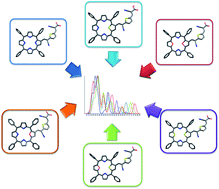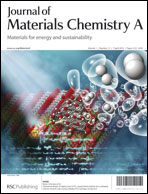Theoretical design of core modified (oxa and thia) porphyrin based organic dyes with bridging thiophene linkers†
Abstract
Density functional theory calculations at the B3LYP/6-31G* level of theory are employed to assess the suitability of core modified porphyrin analogs as organic dyes for solar cell application. The composite photosensitizer consists of a core modified (mono/di oxa and thia substituted) porphyrin as donor bridged at the β-position to the acceptor (cyanoacrylic acid group) by a thiophene unit. The vertical excitation energy of the modeled dyes is calculated using the time-dependent density functional theory (TD-DFT) approach. The designed sensitizers are screened based on their electronic properties, such as HOMO–LUMO gap, position of HOMO–LUMO energy levels with respect to the conduction band of TiO2 and redox potential of the electrolyte, UV-vis absorption spectra etc. The free energy of injection was also evaluated based on the redox properties of the dyes in their ground and excited states. Apart from investigating the electronic structure of the dyes, we have also carried out theoretical calculations to model the interaction of the dye with the surface of the semiconductor by considering a (TiO2)16 nanocluster.


 Please wait while we load your content...
Please wait while we load your content...